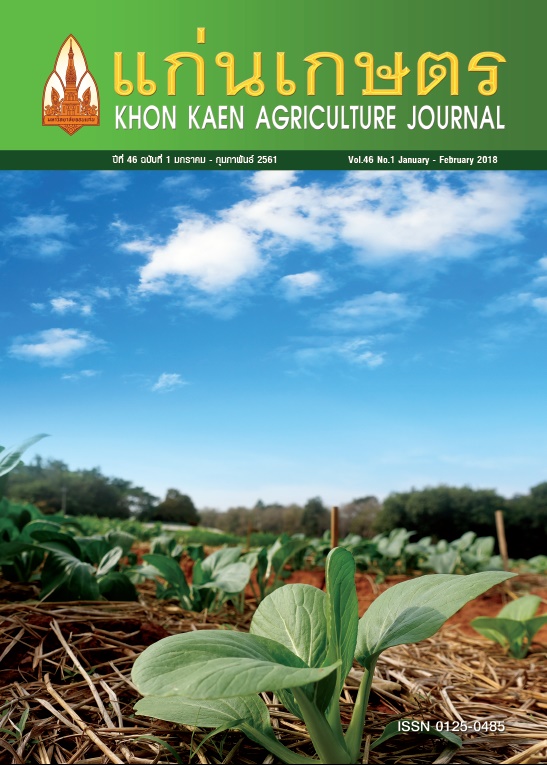ผลของการเสริมน้ำมันมะพร้าวร่วมกับขมิ้นชันในอาหารต่อจำนวนโอโอซีสต์เชื้อบิด สมรรถนะการเจริญเติบโต คุณภาพซาก และสัณฐานวิทยาของลำไส้ในไก่เนื้อ
Main Article Content
บทคัดย่อ
งานวิจัยนี้มีวัตถุประสงค์เพื่อศึกษาผลการเสริมน้ำมันมะพร้าวร่วมกับขมิ้นชันในอาหารต่อจำนวนโอโอซีสต์เชื้อบิด สมรรถนะการเจริญเติบโต คุณภาพซาก และสัณฐานวิทยาของลำไส้ในไก่เนื้อ โดยใช้ลูกไก่เนื้อสายพันธุ์ Cobb 500 อายุ 7 วัน จำนวน 432 ตัว วางแผนการทดลองแบบสุ่มสมบูรณ์ แบ่งกลุ่มทดลองออกเป็น 6 กลุ่มๆ ละ 3 ซ้ำๆ ละ 24 ตัว กลุ่มทดลองได้แก่ กลุ่มที่ 1 กลุ่มควบคุม (C) กลุ่มที่ 2 กลุ่มควบคุมที่เสริมซาลิโนมัยซิน 0.05% (CS) กลุ่มที่ 3 กลุ่มควบคุมที่เสริมขมิ้นชัน 0.50% (CT0.5) กลุ่มที่ 4 กลุ่มที่เสริมน้ำมันมะพร้าว 1% ร่วมกับขมิ้นชัน 0.50% (T0.5C1) กลุ่มที่ 5 กลุ่มที่เสริมน้ำมันมะพร้าว 2% ร่วมกับขมิ้นชัน 0.50% (T0.5C2) และกลุ่มที่ 6 กลุ่มที่เสริมน้ำมันมะพร้าว 3% ร่วมกับขมิ้นชัน 0.50% (T0.5C3) ผลการทดลองพบว่า กลุ่ม CS มีจำนวนโอโอซีสต์เชื้อบิดต่ำที่สุด (P<0.05) อย่างไรก็ตามกลุ่ม T0.5C1 มีแนวโน้มจำนวนโอโอซีสต์เชื้อบิดลดลง ขณะที่การเสริมน้ำมันมะพร้าวร่วมกับขมิ้นชันไม่ส่งผลต่อสมรรถนะการเจริญเติบโต (P>0.05) ส่วนผลต่อคุณภาพซาก พบว่า กลุ่ม T0.5C1 มีเปอร์เซ็นต์ไขมันช่องท้องต่ำกว่ากลุ่ม CS (P<0.01) และผลต่อลักษณะสัณฐานวิทยาของลำไส้เล็ก พบว่า T0.5C1 มีความสูงของวิลไลและอัตราส่วนความสูงของวิลไลต่อความลึกของคริปท์ในลำไส้เล็กส่วนดูโอดินัมสูงกว่าเมื่อเปรียบเทียบกับกลุ่ม C (P<0.05) จากผลการทดลองนี้แสดงให้เห็นว่า การเสริมน้ำมันมะพร้าว 1% ร่วมกับขมิ้นชัน 0.50% (T0.5C1) มีแนวโน้มในการป้องกันเชื้อบิด โดยไม่ส่งผลเสียต่ออัตราการเจริญเติบโต และคุณภาพซากของไก่เนื้อ อีกทั้งยังสามารถพัฒนาความสูงของวิลไล และสัดส่วนความสูงของวิลไลต่อความลึกของคริปท์ในลำไส้เล็กส่วนดูโอดินัม
Article Details
เอกสารอ้างอิง
ชัยวัฒน์ ต่อสกุลแก้ว. 2541. สรีรวิทยาทางเดินอาหาร. ภาควิชาสรีรวิทยา คณะวิทยาศาสตร์ มหาวิทยาลัยมหิดล, กรุงเทพฯ.
ณัฎฐนัณ แสนทวีสุข. 2558. ผลของกรดอินทรีย์ต่อสัณฐานวิทยาของลำไส้เล็กในไก่เนื้อ. ใน: ประชุมวิชาการมหาวิทยาลัยมหาสารคามวิจัย ครั้งที่ 11 วันที่ 20-21 สิงหาคม 2558. มหาวิทยาลัยมหาสารคาม, มหาสารคาม.
ธันวา ไวยบท. 2551. อิทธิผลของสภาวะอุณหภูมิสูงต่อระดับโปรตีนและพลังงานในไก่ไข่. เกษตรพระจอมเกล้า. 26: 124-136.
นพอร ปาลวัฒน์วิไชย. 2550. การเสริมขมิ้นชันผงในอาหารต่อสมรรถนะการเจริญเติบโต ประสิทธิภาพการย่อยและการใช้ประโยชน์ได้ คุณภาพซาก คุณภาพเนื้อ และคอเลสเตอรอลในไก่เนื้อ. วิทยานิพนธ์ปริญญามหาบัณฑิต สาขาสัตวศาสตร์ บัณฑิตวิทยาลัยมหาวิทยาลัยขอนแก่น, ขอนแก่น.
มนิสา นวลเต็ม. 2556. อนาคตของไก่เนื้อไทยในอาเซียน (AEC). สำนักนโยบายและยุทธศาสตร์การค้าสินค้าเกษตร.
มานพ ม่วงใหญ่. 2547. โรคบิดไก่. บริษัทโนวาติส (ประเทศไทย) จำกัด, กรุงเทพฯ.
วิโรจน์ จันทรัตน์. 2527. โรคและการสุขาภิบาลสัตว์ปีก. สถาบันเทคโนโลยีการเกษตรแม่โจ้, เชียงใหม่.
สัญชัย จตุรสิทธา. 2553. เทคโนโลยีเนื้อสัตว์. ภาควิชาสัตวศาสตร์และสัตว์น้ำ คณะเกษตรศาสตร์ มหาวิทยาลัยเชียงใหม่. เชียงใหม่.
สำนักงานเศรษฐกิจการเกษตร. 2559. ปริมาณการส่งออกไก่เนื้อ ปี 2559. กระทรวงเกษตรและสหกรณ์, กรุงเทพฯ.
Arshami, J., M. Pilevar, M. A. Azghadi, and A.R. Raji. 2012. Hypolipidemic and antioxidative effects of curcumin on blood parameters, humoral immunity and jejunum histology in Hy-line hens. AJP. 3: 178-185.
Awad, W.A., K. Ghareeb, S. Abdel-Raheem, and J. BÖhm. 2009. Effects of dietary inclusion of probiotic and symbiotic on growth performance, organ weights and intestinal histomorphology of broiler chicken. Poult. Sci.88: 49-55.
Boerlin, P., and R.J. Reid-Smith. 2008. Antimicrobial resistance: its emergence and transmission. Anim. Health Res. Rev. 9: 115-126.
Bowman, D.D., and R.C. Lynn. 1999. Georgis’ Parasitology for Veterinarians. 7th edition. W.B. saunders Company. Philadelphia, U.S.A.
Boyom, F.F., V. Ngouana, P.H. Amvam Zollo, C. Menut, I.M. Bessiere, I. Gut, and P.I. Rosenthal. 2003. Composition and anti-plasmodial activities of essential oils from some Cameroonian medicinal plants. Phytochemistry. 64: 1269-1275.
Cho, I., S. Yamanishi, L. Cox, B. A. Methe, J. Zavadil, K. Li, Z. Gao, D. Mahana, K. Raju, I. Teitler, H. Li, A. V. Alekseyenko, and M.J. Blaser. 2012. Antibiotics in early life alter the murine colonic microbiome and adiposity. J. Nature. 488: 621-629.
Chomchalow, N. 2011. Health and economic benefits of coconut oil production development in Thailand. AU. J. T. 14: 181-187.
Fabian, M.D. 2015. The properties of lauric acid and their significance in coconut oil. Am. Oil Chem. Soc. 92: 1-15.
Gumila, A. C., M. Ancelin, G. Jeminet, M. Delort, G. Miquel, and H. Vial. 1996. Differential in vitro activities of ionophore compounds against Plasmodium falciparum and mammalian cells. Antimicrob. Agents Chemother. 40: 602-607.
Hayashi, M. Feed additive for livestock and feed for livestock. 1992. United State Patent US-5462967.
Kermanshahi, H., and A. Riasi. 2006. Effect of turmeric powder (Curcuma longa) and soluble NSP degrading enzyme on some blood parameters of laying hens. Poult. Sci. 5: 494-498.
Kim, D.K., H.S. Lillehoj, S.H. Lee, S.I. Jang, E.P. Lillehoj, and D. Bravo. 2013. Dietary Curcuma longa enhances resistance against Eimeria maxima and Eimeria tenella infections in chickens. Poult. Sci. 92: 2635-2643.
Kongmun, P., M. Wanapat, P. Pakdee, C. Navanukraw, and Z. Yu. 2011. Manipulation of rumen fermentation and ecology of swamp buffalo by coconut oil and garlic powder supplementation. Live. Sci. 136: 84-92.
Li, D.F., R.C. Thaler, J.L. Nelssen, D.L. Harmon, G.L. Allee, and T.L. Weeden. 1990. Effect of fat sources and combinations on starter pig performance, nutrient digestibility and intestinal morphology. Anim. Sci. 68: 3694-3704.
Marten, B., M. Pfeuffer, and J.R. Schrezenmeir. 2006. Medium-chain triglycerides. Int. Dairy J. 16: 1374-1382.
Martins-Rodrigues, M.A., D.A. Oliveira Silva, E.A. Taketomi, and F.J. Hernandez-Blazquez. 2007. IgA production, coliforms analysis and intestinal mucosa morphology of piglets that received probiotics with viable or inactivated cells. Pesq. Vet. Bras. 27: 241-245.
Masuda, T. S. Yonemori, Y. Oyama, Y. Takeda, T. Tanaka, T. Andoh, A. Shinohara, and M. Nakata. 1999. Evaluation of the antioxidant of environmental plants: activity of the leaf extracts from seashore plants. J. Agric. Food Chem. 47: 1749-1754.
Sato, H., A. Nitanai, T. Kurosawa, and S. Oikawa. 2004. Anticoccidial efficacy of medium-chain triglycerides (MCT) in calve. J. Vet. Med. Sci. 66: 1583-1585.
SPSS for windows 9.0. 1998. SPSS Inc., Chicago, IL.
Steel, R.G.D., and J.H. Torrie. 1980. Principles and Procedures of Statistics: A Biometerial Approach, 2nd ed. McGraw-Hill, New York, U.S.A.
Tan, G.H., and K. Long. 2012. Preliminary study of anticoccidial activity of medium chain fatty acids (MCFA) and their corresponding monoglycerides on broiler chicken coccidiosis. Int. J. Biotech. Well. Indus. 1: 134-141.
Uni, Z., S. Ganot, and D. Sklan. 1998. Posthatch development of mucosal function in the broiler small intestine. Poult. Sci. 77: 75-82.
Wang, J., X. Wang, J. Li, Y. Chen, W. Yang, and L. Zhang. 2015. Effects of dietary coconut oil as a medium chain fatty acid source on performance, carcass composition and serum lipids in male broilers. Asian-Aust. J. Anim. Sci. 28: 223-230.


